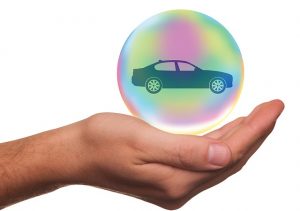Top Causes of Accidents on the Road

Road accidents are one of the leading causes of death in the United States, with nearly 1.3 million people dying in road crashes annually. On average, that’s about 3,287 road accident-related deaths per day. This doesn’t cover the 20-50 million drivers that are left injured or even disabled from a collision.
Although some causes of accidents seem easy to avoid with appropriate driving habits, it’s easy for anyone to become distracted behind the wheel. Therefore, this list of the top five causes of road accidents aims to remind everyone what the consequences are for any dangerous driving activity.
1) Distracted Driving
Contrary to the belief that drunk driving is the most common reason for road accident death, distracted driving actually accounts for 25% of all vehicle deaths annually. Teens are most responsible, with approximately 58% of teen crashes being the result of this form of reckless behavior.
Distracted driving mostly accounts for texting behind the wheel, but is generally defined as operating a motor vehicle while engaging in another activity. This can also include using a GPS, eating, searching for a lost item, applying makeup, or adjusting the stereo.
Each state has strict laws about distracted driving to prevent anyone from multitasking in their cars. It’s important to research and follow these laws to avoid serious consequences such as license suspension.
2) Speeding
The classic phrase “Speeding kills” has never been truer. It’s common for commuters or long-distance highway drivers to speed 10, 20, and over 30 miles per hour, but those in a hurry should consider how greatly speeding impacts a driver’s ability to react if an on-road obstacle comes their way.
Speed increases the impact and fatality of all accidents and can transform what could have been a light fender bender into a tragic death.
3) Drunk Driving
Thankfully drunk driving awareness and state preventative measures have only increased, but driving under the influence is still a serious problem in the United States. Alcohol-impaired drivers in the United States kill approximately 29 people each day.
Not only will drunk driving take the life of an innocent person, but it will also result in jail time, big fines, and legal fees for the convicted driver. Not to mention the ruined lives of the deceased’s friends and family. It’s a mess nobody should get into, which is why it’s important for everyone to consider how much-drunk driving has the potential to change dozens of lives in mere seconds.
4) Reckless Driving
Reckless drivers are either impatient commuters or thrill seekers who put everyone’s lives in jeopardy for their own gain. Reckless drivers have the potential to be ticketed, fined, and arrested for multiple offenses such as swerving between lanes, sudden stops, fast turns, running red lights or stop signs, and failing to signal.
Other drivers will find it difficult to react quickly to these driving decisions and may fail to avoid a reckless driver. A criterion for drivers should be allowing yourself and everyone around you enough time to react to unexpected hazards. Reckless driving sacrifices reaction time for unruly and unnecessary behavior.
5) Rain
Although a turbulent rainstorm can happen without warning or preparation, everybody can adjust their driving according to disorderly weather. However, many fail to adjust speed or allow additional time for breaking and therefore cause terrible accidents.
Rain-related accidents cause on average 556,151 crashes per year, which is 10% of all vehicle accidents. Anyone can prevent a weather-related accident like this by slowing down and ensuring all signaling and operative lights on a vehicle are working and being used properly.
Recommended Reading:
- What to Do after a Car Accident
- Six Tips to Avoid Car Accidents
- 6+ Accidents That Lead To A Personal Injury Lawsuit
- A Guide to Filing a Car Accident Claim
- What to Look for in a Car Accident Lawyer?
6) Fatigue
Fatigue is a major cause of accidents on the road because it impairs a driver’s ability to stay alert and focused.
When we are tired, our reaction time slows down, and we find it harder to pay attention to the road and other vehicles. It’s like trying to drive with a foggy mind.
Fatigue can even lead to brief moments of unintentional sleep called microsleep, where drivers may doze off for a few seconds without realizing it. Just imagine closing your eyes for a few seconds while driving!
It’s incredibly dangerous, especially when traveling at high speeds. Fatigue also increases the likelihood of taking risks on the road, as our judgment becomes compromised.
That’s why it’s so important to get enough rest before getting behind the wheel to ensure we can stay focused and react quickly to any unexpected situations that may arise.
7) Poor road conditions
Poor road conditions contribute to accidents on the road because they create hazards and challenges for drivers.
When roads are in disrepair, filled with potholes, or have uneven surfaces, it becomes difficult for drivers to maintain control of their vehicles.
Uneven road surfaces can cause vehicles to lose traction, resulting in skidding or spinning out of control. Inadequate signage or poorly marked lanes can lead to confusion and increase the risk of collisions.
Additionally, roads with insufficient lighting make it harder for drivers to see pedestrians, cyclists, or other vehicles, increasing the likelihood of accidents, especially at night.
Poor road conditions also include poorly designed intersections or lack of proper traffic controls, which can lead to a higher potential for collisions.
8) Vehicle defects
Vehicle defects are a primary reason for accidents on the road because they compromise the safety and functionality of the vehicle.
When a vehicle has defects, such as faulty brakes, worn-out tires, or malfunctioning lights, it significantly increases the risk of accidents. For example, if the brakes fail to work properly, the driver may be unable to stop the vehicle in time to avoid a collision. Similarly, worn-out tires reduce traction and make it harder for the driver to maintain control, especially in adverse weather conditions.
Malfunctioning lights, such as broken headlights or taillights, can impair visibility, making it difficult for other drivers to see the vehicle or anticipate its movements.
Other defects like steering problems or issues with the suspension can also compromise the driver’s ability to maneuver the vehicle safely.
Regular maintenance and prompt repair of vehicle defects are essential to ensure that the vehicle operates properly and minimizes the risk of accidents caused by mechanical failures.
9) Poor visibility
Poor visibility is a significant reason for accidents on the road because it impairs a driver’s ability to see and anticipate potential hazards.
When visibility is compromised, such as during heavy rain, fog, or at night, it becomes challenging to detect pedestrians, cyclists, other vehicles, or obstacles on the road.
Reduced visibility makes it harder to judge distances and accurately assess the speed and direction of other vehicles, increasing the likelihood of collisions.
Additionally, poor visibility hampers the effectiveness of road signs and traffic signals, making it difficult for drivers to navigate safely and follow traffic regulations. It is crucial for drivers to adjust their speed, increase their following distance, and use appropriate lighting and windshield wipers in conditions of poor visibility to mitigate the risk of accidents.
Moreover, road authorities can enhance road safety by improving lighting conditions, ensuring clear road markings, and installing reflective signs to help drivers navigate safely even in challenging visibility conditions.
10) Tailgating
Tailgating, or following another vehicle too closely, is a significant reason for accidents on the road because it reduces the safety buffer between vehicles and leaves little room for error.
When a driver tailgates, they have less time to react to sudden stops or changes in traffic conditions. This behavior increases the risk of rear-end collisions, which can result in significant damage and injuries.
Tailgating also creates a domino effect, as the driver in the front may need to brake suddenly, leading to a chain reaction of collisions involving multiple vehicles.
Moreover, tailgating can cause stress and anxiety for the driver in front, potentially leading to poor decision-making or aggressive behavior. It’s crucial to maintain a safe distance from the vehicle ahead, allowing enough space to stop safely if needed.
Keeping a proper following distance gives drivers more time to react, helps prevent collisions, and promotes smoother traffic flow.
Always Be Prepared
Although nobody ever wants to be involved in an accident, it’s important to always be prepared for the worst. Regardless of who’s to blame, accidents leave behind disastrous effects such as denial of coverage by insurance, property damage, large medical bills, and death.
If you are involved in an accident that wasn’t your fault and are struggling to receive proper compensation from the guilty party, insurance company, or car manufacturer, it’s critical to seek help and receive fair compensation.






